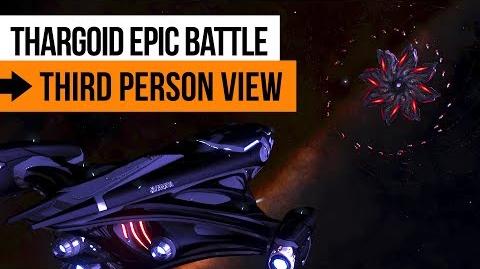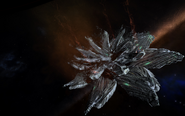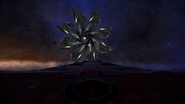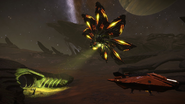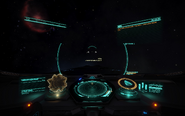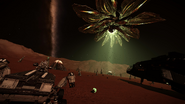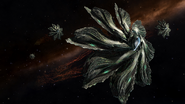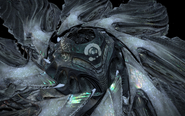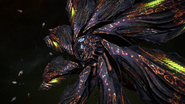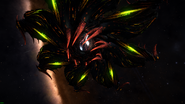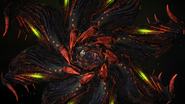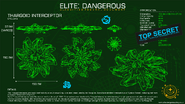The Thargoid Interceptor,[1] previously identified only as an Unknown Ship, is an alien vessel used by the Thargoids. Three Interceptor subtypes have been identified: the "Cyclops Variant", the "Basilisk Variant", and the "Medusa Variant".
History
First Contact
Active Thargoid Interceptors were first encountered on January 5, 3303. Commanders were interdicted by Thargoid Interceptors while traveling through hyperspace and pulled into normal space with their systems disabled, after which they were scanned and the Interceptors jumped away. Wreckage from Interceptors had been found on various planets and moons near the Pleiades Nebula following an initial discovery on August 30, 3302, but it was not known at the time that the wreckage belonged to an extant species, and nothing yet tied it directly to the Thargoids.
While encounters with Interceptors were limited to hyperspace interdictions and passive scanning for independent pilots for several months, destroyed Federation military convoys began appearing with battle damage from highly unusual weapons. Sightings of Thargoid Interceptors in the vicinity of the convoys implied they were the perpetrators, though the motive for such attacks remained a mystery.
Connection to Alien Structures
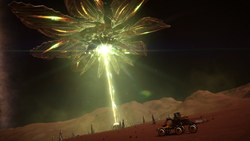
Thargoid Interceptor Barnacle laser
On June 2, 3303, CMDR Mobiusetti documented the first known interaction between a Thargoid Interceptor and Alien Structures on Pleiades Sector OI-T C3-7 A 6 at coordinates -42.778, -21.713, confirming the two are related. The Interceptor approached one Alien Structure, incapacitating any nearby ships and SRVs. The craft then rotated until its propulsion array faced and was aligned with the Alien Structure, before drawing a pulsing beam of light or energy from it for a brief period. The Interceptor then departed as rapidly as it arrived. It is possible that Alien Structures serve as refueling stations of some kind for Interceptors, and the Meta-Alloys they produce are fuel or repair materials for them, but this is currently only conjecture.[2]
Confirming Origins
Professor Palin determined the vessels' origin by comparing data from the Unknown Ships with older Thargoid samples. Palin's experiments resulted in conclusive proof that the Unknown Ships were Thargoid.[3]
The research data was seized by Federal agents who wanted to convey it to a Federal research facility. However, the ships carrying the data were attacked by Thargoid vessels and the data leaked into the public domain. The Federal Times conducted further research on the cryptic data before publishing the report on June 16, 3303.
The Return
Beginning on September 26, 3303, "Cyclops Variant" Thargoid Interceptors began indiscriminately attacking independent pilots in addition to Federal and Imperial fleets. Sightings have been confirmed at sites classified as "Non-Human Signal Sources" in the vicinity of the Pleiades Nebula, where they could be observed monitoring wreckage of human ships and retrieving Thargoid-related objects such as Thargoid Sensors, Thargoid Probes, and Meta-Alloys. Interceptors have also been reported at Alien Structure fields.[4]
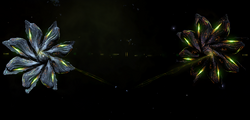
A Cyclops (left) and Basilisk (right) collecting meta-alloys
On November 13, 3303, a second Interceptor type was discovered by CMDR Factabulous: the "Basilisk Variant".[5] Basilisk Variants are primarily distinguished from Cyclops Variants by their darker hull coloration with red scarring and a fifth Thargoid Heart, but they also possess significantly increased offensive and defensive capabilities. It is believed that Basilisk Variants are older vessels that have weathered more battles.[6] Basilisk Variants and Cyclops Variants do not currently appear to be hostile towards each other, and have even been sighted peacefully collecting meta-alloys together.[7]
A third Interceptor type, the "Medusa Variant", was witnessed attacking three stations on December 14, 3303.[8] The Medusa, identified by the vibrant red spikes on their petals and surrounding the cockpit, surpassed even the capabilities of the Basilisk.[9] Analysis of the Thargoid Medusa Tissue Sample shows that the vessel has bio-mechanical tissue. The Medusa appeared to be older and more developed with denser biological matter and more intricate technological elements than samples of the Cyclops and Basilisk.[10] Three more stations were attacked by Medusa Interceptors on December 21st.[11]
Capabilities
Variants
| Variant | Thargoid Hearts | Thargon Swarm Size | USS Threat Level | Notes |
|---|---|---|---|---|
| Cyclops | 4 | 32 | 5 | Initially non-hostile unless provoked by scanning repeatedly, attacking, or approaching closely. Attacks immediately if it detects that a pilot is carrying Thargoid technology. |
| Basilisk | 5 | 64 | 6 | Initially non-hostile but more easily provoked than a Cyclops. Attacks immediately if it detects that a pilot is carrying Thargoid technology. |
| Medusa | 6 | 96 | 7 | Sometimes hostile immediately, and very easily provoked by approaching it. Attacks immediately if it detects that a pilot is carrying Thargoid technology. |
Design
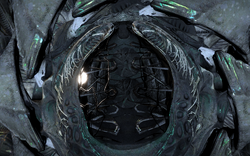
Thargoid Interceptor cockpit
All Thargoid Interceptors use the same organic design: while the apparent "cockpit" of the vessel is at the bow and the propulsion mechanism at the stern as is typical of human starships, the central structure of the vessel is vertically-oriented and features an octagonal symmetry. Eight large "petals" surround the cockpit, and are capable of extending and contracting. Similarly, eight smaller petals surround the propulsion mechanism; these are extended when the vessel is moving, and flattened when it is stationary. In place of mechanical subsystems, Interceptors possess organic modules called "Thargoid Hearts", which are capable of repairing hull damage. Interceptors emit various sounds and colours, which may be a form of communication.
A symbol is visible above each Intercept's cockpit. Although the meanings of these symbols or lexigrams are unknown, numerous configurations have been documented, and it is believed that each configuration may denote a specific role that the ship serves or a division within the Thargoid hierarchy to which it belongs. Basilisk Variant Interceptors display multiple symbol features which are absent from Cyclops Variants.[12]
Close-up inspection of the Interceptor's cockpit shows two circular, hatch-like apertures inside, but no pilot or control panel is visible. No escape pods are ever found among Interceptor wreckage either. It is possible that Interceptors are remotely-piloted or even autonomous, and their organic design implies that if this is the case, they may be engineered organisms that were created by the Thargoids.[13]
Weaponry
Until September 26, 3303, very little was known about the capabilities of Thargoid Interceptors. The ships have since demonstrated an array of formidable weaponry and defenses. When either approached or threatened by deployed hardpoints, an Interceptor will emit a dark red glow and deploy a swarm of Thargon drones. Firing on an Interceptor causes the Thargoid to immediately return fire by sending the Thargons after its attacker. While the Thargons are extremely fast and fire projectiles that penetrate shields and directly damage the hull, the Interceptor itself will also fire fast and seemingly unavoidable red projectiles.
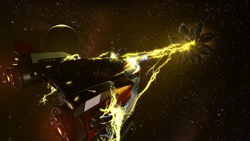
An Interceptor's energy attack
After one of an Interceptor's Thargoid Hearts are destroyed, the Interceptor will respond by unleashing a powerful secondary attack in the form of lightning-like energy beams. The attack is preceded by flashing yellow lights on the ship's hull and has very short range, allowing it to be avoided by skillful piloting. This weapon inflicts heat damage, drains shields, causes a random module malfunction, reboots Shield Boosters, and disrupts Thrusters.[14]
Some Interceptors will also give chase to any CMDRs trying to flee. They may launch Caustic Missiles that will home in on their targets and explode in a cloud of caustic, hull-eating substance.[15]
Basilisk Variant Interceptors display an additional defensive behavior. After a Basilisk Variant loses a Thargoid Heart, if another Heart is not destroyed within seven minutes, the ship will enter an "enraged" state that dramatically increases its lethality. It will instantly respawn its Thargon Swarms, increase the frequency of its Caustic Missile attacks, and fire more Caustic Missiles in each volley.[16]
Interdiction and Jumping
The Interceptors also have the ability to interdict human ships traveling through hyperspace: Commanders experiencing an interdiction are alerted by their ships that their hyperspace conduit has become unstable shortly before dropping out of hyperspace due to a Frame Shift Drive malfunction. All ship systems and controls with the exception of Life Support are disabled by the interdiction, similar to the effect produced by scanning Thargoid Probes, but with a longer duration.
Thargoid Interceptors are known to have scanners of some kind which they utilize on those whom they interdict, as well as jump drives that leave a hitherto undocumented wake signature. While the wake signature can be scanned, it is unidentifiable, currently making impossible to pursue an Interceptor; attempting to charge the FSD with this signature as the destination results in another FSD malfunction.
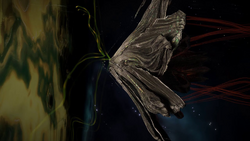
Thargoid Interceptor Witch Space Wormhole
The Interceptor can create a stable wormhole to hyperspace (witch-space). A green beam extends forward which opens up space to jump through. The Interceptor's wings fold just before the jump. Human ships are repelled by an unknown force when trying to enter the wormhole.[17]
Vulnerabilities
Following the introduction of Aegis-developed countermeasures, the AX Missile Rack and AX Xeno Scanner, on September 28, 3303, the first reports emerged of CMDRs successfully destroying Thargoid Interceptors. Although Interceptors are either highly damage-resistant or outright impervious to conventional weaponry, specially-calibrated AX Missiles have proven capable of harming them.
Likewise, the AX Xeno Scanner has provided a wealth of new data on Interceptors. The vessels can gradually regenerate any external damage, but possess "Hearts" that serve as an organic analogue to shipboard subsystems. These Thargoid Hearts can only be targeted once the ship has been active-scanned by the AX Xeno Scanner. Cyclops Variants have four hearts, while Basilisk Variants have five.
When an Interceptor suffers hull damage, it uses one Heart to regenerate, after which the Heart enters an "Exerted" state and can be destroyed. Every Heart lost reduces the Interceptor's hull by 20%. After three Hearts are destroyed, the Interceptor emits an EMP-like pulse and activates its shield, and after all four are gone it will cease to regenerate and rely on recharging its shield repeatedly. Thargoid Hearts can be salvaged from destroyed Interceptors.
All Aegis-developed weapons and devices serve specialized roles in combating Thargoid Interceptors. The AX Xeno Scanner is necessary to identify and target an Interceptor's four Hearts. The AX Missile Racks should be used to damage the Interceptor's hull and trigger the Hearts' exerted state. The AX Multi-cannon is best suited for destroying the Hearts after they are exerted. The Remote Release Flak Launcher is highly effective at eliminating Thargon Swarms. Lastly, the Shutdown Field Neutraliser counters the effects of the Interceptor's disabling pulse.
Notable Encounters
| Approx. Location | Variant | Date | Notes |
|---|---|---|---|
| Pleiades Sector OI-T C3-8 | Cyclops | Jan. 5, 3303 | First ever encounter of a Thargoid Interceptor by Commander DP Sayre; Video, PC Gamer interview |
| Aries Dark Region ON-T C3-10 | Cyclops | Jan. 6, 3303 | Video |
| Pleiades Sector WK-N B7-2 | Cyclops | Jan. 6, 3303 | Video |
| Pleiades Sector WO-A C1 | Cyclops | Jan. 6 3303 | Video |
| Pleiades Sector DR-M B7-0 | Cyclops | Jan. 6, 3303 | Video |
| Electra | Basilisk | Nov. 13, 3303 | First encounter of a Basilisk Variant Thargoid Interceptor by CMDR Factabulous[5] |
| HR 1185 | Basilisk | Nov. 15, 3303 | Two Basilisks near a destroyed Majestic Class Interdictor, found by CMDR Okzide[18] |
| HIP 16753 | Medusa | December 14, 3303 | One of the first encounters of a Medusa Variant by CMDR Cookie Jarviz |
Notes
- It is a common misconception that carrying an Thargoid Sensor or having carried one at some point affects or triggers an encounter with a Thargoid Interceptor. Extensive player testing has confirmed that Thargoid Sensors have no effect on a player's chance for an encounter, which is believed to be purely random.
- Encounters are seemingly limited to an undefined area around the Pleiades Nebula and Maia.[19] Some players have reported encounters in systems as far as 235 ly away from Merope.[20]
- When players are interdicted by a Thargoid interceptor, they drop out of hyperspace at a random location within the star system they were originally trying to jump from.
- If not equipped with an AX Xeno Scanner, a basic scan by targeting the ship will provide Unknown Ship Signature encoded data, while scanning the ship's wake will provide Unknown Wake Data. Both of these will appear in your ship's data list, though they do not appear to have Engineering applications at this time.
- When a Thargoid Interceptor is preparing to enter hyperspace, it creates a portal or wormhole similar to those made by Farragut Battle Cruisers and Majestic Class Interdictors. It is impossible to enter this portal as the player's ship is rebuffed by an invisible force.
- The power-outage effect of the interdiction appears to go much further than that of the unknown probes. In additional to shutting down modules and the HUD, all non-functional instruments in the cockpit switch off, including the illuminated keyboard in the Sidewinder, the core monitors on the Diamondback Scout and all lights and holographic displays in the Imperial Cutter. Despite this, life support does not appear to be affected.
- Beginning with update 2.3 (and originally seen in the 2.3 beta), Thargoid Interceptor can be encountered through certain distress call missions. Upon dropping out of supercruise at the source of the distress call, the player arrives in a green, gaseous cloud and their ship is disabled. Multiple Federal Corvette wrecks, bearing luminescent green residue where they are damaged and with their crews apparently dead, are adrift in the cloud, and a single Unknown Ship can be seen jumping away. Presumably, the Interceptor destroyed all of the Corvettes on its own. A black box canister, the objective of the mission, can be salvaged from the wreckage.
- With 2.4, The Return, Thargoid Interceptors can be found picking up various items from Non-Human Signal Sources. These items include Thargoid Sensors, Thargoid Probes, Meta-Alloys, and Damaged Escape Pods.
- When destroyed, a Thargoid Interceptor produces a large, corrosive cloud which can severely damage the shields and hull of any ship that pass through it.
Videos
Gallery
References
- ↑ Galactic News: Federal Capital Ship Destroyed by Thargoids
- ↑ YouTube: They're Here...
- ↑ Galactic News: The Thargoids have Returned
- ↑ Galactic News: Further Thargoid Attacks
- ↑ 5.0 5.1 https://www.youtube.com/watch?v=haNzZlJyO1k
- ↑ Galactic News: Previously Unseen Thargoid Ships in Electra
- ↑ /r/EliteDangerous: Threat 6 USS in Electra
- ↑ YouTube: Commander Chronicles: Devastation - Elite Dangerous
- ↑ /r/EliteDangerous: So the Thargoids(?) Attacked a Station. Images Courtesy of CMDR Bad_Player - Comment by ChristianM
- ↑ Thargoid Medusa Tissue Sample
- ↑ Galactic News: More Starports Attacked
- ↑ https://www.reddit.com/r/EliteDangerous/comments/7crwim/thargoid_lexigram_chart_updated_with_basilisk/
- ↑ https://forums.frontier.co.uk/showthread.php/380313-Close-up-pictures-of-a-Thargoid
- ↑ r/EliteDangerous: had to run but what the HELL WAS THAT ATTACK? ripped through my shields like butter.
- ↑ r/EliteDangerous: Aw crap
- ↑ /r/EliteDangerous: Some tips for the new Thargoids by PrimeNine, a developer.
- ↑ /r/EliteDangerous: Elite: Dangerous: Another INRA Base Found, Linked To Hyperdrive Research
- ↑ https://www.reddit.com/r/EliteDangerous/comments/7d2g37/thargoid_basilisk_spoted_in_hr_1185/
- ↑ Elite Dangerous Forums: Plotting Alien Ship Pulls - Need Your Help Commanders!
- ↑ /r/EliteDangerous: Unknown Ships have breached the UA Shell! Just got interdicted 215LY from Merope!
| Playable |
| ||||||||||||||||||||
| NPC-only |
| ||||||||||||||||||||
| Lore & Concepts |
| ||||||||||||||||||||
| |||||||||||||||||||||
| Ships marked with H can only be purchased and operated by players who pre-ordered Horizons. | |||||||||||||||||||||


